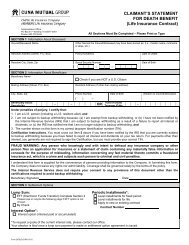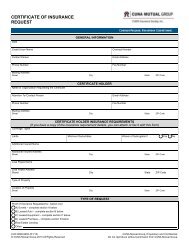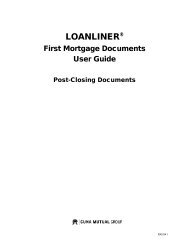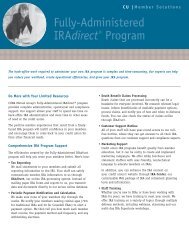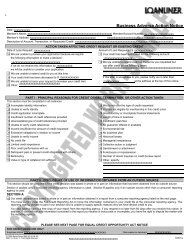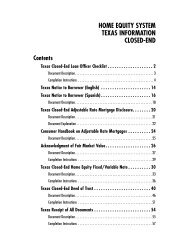Retirement Plan IN-SERVICE WITHDRAWAL FORM - CUNA Mutual ...
Retirement Plan IN-SERVICE WITHDRAWAL FORM - CUNA Mutual ...
Retirement Plan IN-SERVICE WITHDRAWAL FORM - CUNA Mutual ...
You also want an ePaper? Increase the reach of your titles
YUMPU automatically turns print PDFs into web optimized ePapers that Google loves.
<strong>Retirement</strong> <strong>Plan</strong> ServicesP.O. Box 2978 • 5910 Mineral Point RoadMadison, WI 53701-2978Phone: 800.999.8786 • Fax: 608.236.8017www.benefitsforyou.com<strong>Retirement</strong> <strong>Plan</strong><strong>IN</strong>-<strong>SERVICE</strong> <strong>WITHDRAWAL</strong> <strong>FORM</strong>DEF<strong>IN</strong>ED CONTRIBUTION PLANS(Subject to QualifiedJoint & Survivor Requirements)Note: Do not use this form if you haveterminated your employment. Usea <strong>Retirement</strong> <strong>Plan</strong> Distribution Form.1102-2064 (R3-14)
Information Regarding Your <strong>Retirement</strong> <strong>Plan</strong> BenefitsYour <strong>Plan</strong> Representative can assist you in completing theIn-Service Withdrawal Form.Before you complete this form, please do the following:• Review your most recent employee statement for the approximate vested benefits you may receive.You can obtain your most current account information from our Web site at www.benefitsforyou.comor call <strong>Retirement</strong> <strong>Plan</strong> Services at (800) 999-8786.• Your account will be assessed a $50 distribution fee if your vested balance is $100 or greater.• If your vested account balance is greater than $5,000, read the “Qualified Joint and Survivor AnnuityNotice.” If you are married, your spouse must also read this notice.• Read the “Special Tax Notice Regarding <strong>Retirement</strong> <strong>Plan</strong> Payments.” The law requires that you begiven this information to help you decide how to receive your retirement plan benefits.• You need to complete appropriate Sections I through VII. After completing these sections, givethis form to your <strong>Plan</strong> Representative. DO NOT RETURN IT TO <strong>CUNA</strong> MUTUAL GROUP.• The <strong>Plan</strong> Representative must complete Section VIII. The In-Service Withdrawal Form needs to bereviewed by the <strong>Plan</strong> Representative to make sure all applicable sections are completed and thatthe form has the necessary signatures.• The processing of the benefit will be delayed if this form is not completed in its entirety.Page 2
QUALIFIED JO<strong>IN</strong>T AND SURVIVOR ANNUITY NOTICE(applicable if your vested account balance is greater than $5,000)What is a Qualified Joint and Survivor Annuity (QJSA)?Your plan states the automatic form of retirement benefit is a Qualified Joint and Survivor Annuity,unless you choose a different form of payment. If you are married, this Joint and Survivor Annuity formof payment provides you with monthly payments for your life. Upon your death, your spouse will receivea monthly payment equal to 50% of the monthly payment you received prior to your death. Your spousewill receive this survivor benefit for the rest of his or her life. If you are not married, the QJSA will be paidto you in the form of a single life annuity unless you choose a different form of payment. A single lifeannuity gives you a monthly retirement payment for the rest of your life. Upon your death, no furtherbenefits will be paid.What other forms of payment can I choose?The most common forms of non-QJSA payment include: lump sum, installments and annuities. Referto your Summary <strong>Plan</strong> Description for the benefit options available in your plan. If you are married,your spouse must consent to the non-QJSA form of payment you elect. Your spouse’s consent mustbe in writing and witnessed by a notary public or the <strong>Plan</strong> Representative/<strong>Plan</strong> Representative. Thefollowing chart illustrates the financial effect of the various payment options available:BENEFITOPTIONJoint and50%SurvivorJoint and100%SurvivorSingle LifeAnnuityLife Annuitywith 5 YearCertainPeriodLife Annuitywith 10 YearCertainPeriodCashDESCRIPTION(You are the participant)ESTIMATED MONTHLYPAYMENT*Participantat age 65Spouseat age 65You receive monthly payments for life. After your death, your spousereceives 50% of your monthly payment for the rest of his or her life. $52 $26You receive monthly payments for life. After your death, your spousereceives 100% of your monthly payment for the rest of his or her life. $48 $48You receive monthly payments for life. Payments stop when you die. Yourspouse or other beneficiary will receive no further payments.$58 $0You receive monthly payments for life. If you die before 5 years, yourspouse or other beneficiary receives the remaining 60 guaranteed monthlypayments. If you die after 5 years, your spouse or other beneficiary willreceive no further payments.You receive monthly payments for life. If you die before 10 years, yourspouse or other beneficiary receives the remaining 120 guaranteedmonthly payments. If you die after 10 years, your spouse or otherbeneficiary will receive no future payments.You and your spouse, if any, agree to take a lump sum cash distributionnow and receive no future payments.$57 $0$56 $0$0 $0*Based on a $10,000 withdrawal. The amounts shown are for illustration only. The actual amount of monthly benefit willdepend on annuity purchase rates in effect at the time of purchase and may result in higher or lower amounts. Contact our<strong>Retirement</strong> and Investment Solutions Center** for a current quote at 800-999-8786, option 3.** Representatives are registered, securities are sold, and investment advisory services offered through <strong>CUNA</strong> Brokerage Services, Inc. (CBSI), member F<strong>IN</strong>RA/SIPC, a registered broker/dealer andinvestment advisor, 2000 Heritage Way, Waverly, Iowa 50677, toll-free (866) 512-6109. Non-deposit investment and insurance products are not federally insured, involve investment risk, may losevalue and are not obligations of or guaranteed by the financial institution. CBSI is under contract with the financial institution, through the financial services program, to make securities and insuranceproducts available to members. <strong>Retirement</strong> and Investment Solutions Center team members offer retirement education and do not provide investment, legal or tax advice. Participants are encouraged toconsult their own advisors.Page 3
SPECIAL TAX NOTICE REGARD<strong>IN</strong>G RETIREMENT PLAN PAYMENTSThis notice explains how you can continue to defer federal income tax on your retirement savings and contains important information youwill need before you decide how to receive your <strong>Plan</strong> benefits.This notice is provided to you because all or part of the payment that you will soon receive from the <strong>Plan</strong> may be eligible for rollover byyou or your <strong>Plan</strong> Representative to an IRA (traditional or Roth) or an eligible employer plan. A rollover is a payment by you or the <strong>Plan</strong>Representative of all or part of your benefit to another plan or IRA that allows you to continue to postpone taxation of that benefit until it ispaid to you. In general, your payment cannot be rolled over to a SIMPLE IRA or a Coverdell Education Savings Account (formerly knownas an education IRA). However, any Roth 401(k) deferrals can be rolled over to a Roth IRA or any eligible plan that accepts rollover ofRoth deferrals. An “eligible employer plan” includes a plan qualified under section 401(a) of the Internal Revenue Code (“Code”), includinga 401(k) plan, profit-sharing plan, defined benefit plan, stock bonus plan, and money purchase plan; a section 403(a) annuity plan; asection 403(b) tax-sheltered annuity; and an eligible section 457(b) plan maintained by a governmental employer (governmental 457plan).An eligible employer plan is not legally required to accept a rollover. Before you decide to roll over your payment to another employerplan, you should find out whether the plan accepts rollovers and, if so, the types of distributions it accepts as a rollover. You should alsofind out about any documents that are required to be completed before the receiving plan will accept a rollover. Even if a plan acceptsrollovers, it might not accept rollovers of certain types of distributions, such as after-tax or designated Roth amounts. If this is the case,and your distribution includes after-tax and/or designated Roth amounts, you may wish instead to roll your distribution over to a traditionalIRA or, for designated Roth amounts, a Roth IRA or split your rollover amount between the employer plan in which you will participate andan IRA. If an employer plan accepts your rollover, the plan may restrict subsequent distributions of the rollover amount or may requireyour spouse’s consent for any subsequent distribution. A subsequent distribution from the plan that accepts your rollover may also besubject to different tax treatment than distributions from this <strong>Plan</strong>. Check with the administrator of the plan that is to receive your rolloverprior to making the rollover.If you have additional questions after reading this notice, you can contact your <strong>Plan</strong> Representative.SUMMARYThere are two ways you may be able to receive a <strong>Plan</strong> payment that is eligible for rollover:(1) Certain payments can be made directly to an IRA or to an eligible employer plan that will accept it and hold it for your benefit (“DIRECTROLLOVER”); or(2) The payment can be PAID TO YOU.If you choose a DIRECT ROLLOVER:• Your payment will not be taxed in the current year and no income tax will be withheld.• You choose whether your payment will be made directly to your traditional IRA, a Roth IRA, or to an eligible employer plan thataccepts your rollover. Your payment cannot be rolled over to a SIMPLE IRA, or a Coverdell Education Savings Account. If your benefitunder the <strong>Plan</strong> is subject to a mandatory cashout rule, absent your election otherwise, the <strong>Plan</strong> Representative may be required todirect your payment to a traditional IRA or a Roth IRA it establishes for you. If your payment is subject to this rule, your <strong>Plan</strong>Representative is required to let you know and to provide you with information regarding the IRA(s) to be established on your behalf.• The taxable portion of your payment will be taxed later when you take it out of the traditional IRA, the eligible employer plan, or, fornonqualified distributions, the Roth IRA. Depending on the type of plan, the later distribution may be subject to different tax treatmentthan it would be if you received a taxable distribution from this <strong>Plan</strong>.If you choose to have a <strong>Plan</strong> payment that is eligible for rollover PAID TO YOU:• You will receive only 80% of the taxable amount of the payment, because the <strong>Plan</strong> Representative is required to withhold 20% of thatamount and send it to the IRS as income tax withholding to be credited against your taxes.• The taxable amount of your payment will be taxed in the current year unless you roll it over. Under limited circumstances, you may beable to use special tax rules that could reduce the tax you owe. However, if you receive the payment before age 59½, you may haveto pay an additional 10% tax.• You can roll over all or part of the payment by paying it to your traditional IRA, your Roth IRA or to an eligible employer plan thataccepts your rollover within 60 days after you receive the payment. The taxable amount rolled over will not be taxed until you take itout of the traditional IRA or the eligible employer plan. For designated Roth amounts rolled over to a Roth IRA, the taxable portion willnot be taxed unless you take a nonqualified distribution.• If you want to roll over 100% of the payment to a traditional IRA or an eligible employer plan, you must find other money to replacethe 20% of the taxable portion that was withheld. If you roll over only the 80% that you received, you will be taxed on the 20% thatwas withheld and that is not rolled over. If your payment includes nontaxable amounts, you may roll over the nontaxable portion to atraditional IRA or a Roth IRA.Your Right to Waive the 30-Day Notice Period.Generally, neither a direct rollover nor a payment can be made from the plan until at least 30 days after your receipt of this notice. Thus, afterreceiving this notice, you have at least 30 days to consider whether or not to have your withdrawal directly rolled over. If you do not wish towait until this 30-day notice period ends before your election is processed, you may waive the notice period by making an affirmative electionindicating whether or not you wish to make a direct rollover. Your withdrawal will then be processed in accordance with your election as soonas practical after it is received by the <strong>Plan</strong> Representative.Page 4
PART I. PAYMENTS THAT CAN AND CANNOT BE ROLLED OVERPayments from the <strong>Plan</strong> may be “eligible rollover distributions.” This means that they can be rolled over to a traditional IRA, a Roth IRA orto an eligible employer plan that accepts rollovers. Payments from a plan cannot be rolled over to a SIMPLE IRA, or a Coverdell EducationSavings Account. Your <strong>Plan</strong> Representative should be able to tell you what portion of your payment is an eligible rollover distribution.Traditional after-tax and Designated Roth Contributions. If you made traditional after-tax and/or designated Roth contributions to the<strong>Plan</strong>, these contributions may be rolled to certain employer plans that accept rollovers of the after-tax and/or designated Roth contributions.In addition, traditional after-tax contributions may be rolled over to a traditional IRA and designated Roth contributions may be rolled over toa Roth IRA. The following rules apply:a. Rollover into an IRA. You can roll over your after-tax contributions to a traditional IRA (and designated Roth contributions to aRoth IRA) either directly or indirectly. Your <strong>Plan</strong> Representative should be able to tell you how much of your payment is thetaxable portion and how much is the after-tax portion or designated Roth portion.If you roll over these amounts to a traditional or Roth IRA, it is your responsibility to keep track of, and report to the IRS on theapplicable forms, the amount of these after-tax and/or designated Roth contributions. This will enable the nontaxable amount ofany future distributions from the IRA to be determined.Once you roll over your after-tax and/or designated Roth contributions to a traditional and/or Roth IRA, those amounts CANNOTlater be rolled over to an employer plan.b. Rollover into an Employer <strong>Plan</strong>. You can roll over after-tax contributions and/or designated Roth contributions from an employerplan that is qualified under Code section 401(a), a section 403(a) annuity plan or a section 403(b) tax-sheltered annuity to anotheremployer plan, annuity plan and/or tax-sheltered annuity using a direct rollover if the other plan or annuity provides separateaccounting for amounts rolled over, including separate accounting for the after-tax employee contributions (plus earnings) and thedesignated Roth contributions (plus earnings). You CANNOT roll over after-tax or designated Roth contributions to agovernmental 457 plan. If you want to roll over your after-tax and/or designated Roth contributions to an employer plan thataccepts these rollovers, you cannot have the after-tax contributions paid to you first. You must instruct the <strong>Plan</strong> Representative ofthis <strong>Plan</strong> to make a direct rollover on your behalf. Also, you cannot first roll over after-tax contributions to a traditional IRA ordesignated Roth contributions to a Roth IRA and then roll over that amount into an employer plan.The following types of payments cannot be rolled over:Payments Spread over Long Periods. You cannot roll over a payment if it is part of a series of equal (or almost equal) payments that aremade at least once a year and that will last for:• your lifetime (or a period measured by your life expectancy), or• your lifetime and your beneficiary’s lifetime (or a period measured by your joint life expectancies), or• a period of 10 years or more.Required Minimum Payments. Beginning when you reach age 70½ or retire, whichever is later, a certain portion of your payment cannotbe rolled over because it is a “required minimum payment” that must be paid to you. Special rules apply if you own 5% or more of youremployer.Hardship Distributions. A hardship distribution cannot be rolled over.Corrective Distributions. A distribution that is made to correct a failed nondiscrimination test or because legal limits on certaincontributions were exceeded cannot be rolled over.Loans Treated as Distributions. The amount of a plan loan that becomes a taxable deemed distribution because of a default cannot berolled over. However, a loan offset amount is eligible for rollover, as discussed in Part III. Ask the <strong>Plan</strong> Representative of this <strong>Plan</strong> ifdistribution of your loan qualifies for rollover treatment.The <strong>Plan</strong> Representative of this <strong>Plan</strong> should be able to tell you if your payment includes amounts which cannot be rolled over.PART II. DIRECT ROLLOVERA DIRECT ROLLOVER is a direct payment of the amount of your <strong>Plan</strong> benefits to a traditional IRA or an eligible employer plan that willaccept it. You can choose a DIRECT ROLLOVER of all or any portion of your payment that is an eligible rollover distribution, as describedin Part I. Except for a DIRECT ROLLOVER of a pre-tax amount to a Roth IRA (see below), the taxable portion of your DIRECT ROLLOVERwill be taxed later when you take it out of the traditional IRA, eligible employer plan, or for Roth IRAs, take a nonqualified distribution. Inaddition, no income tax withholding is required for any taxable portion of your <strong>Plan</strong> benefits for which you choose a DIRECT ROLLOVER.This <strong>Plan</strong> might not let you choose a DIRECT ROLLOVER if your distributions for the year are less than $200.DIRECT ROLLOVER to an IRA (Traditional/Roth). You can open an IRA to receive the direct rollover. If you choose to have yourpayment made directly to an IRA, contact an IRA sponsor (usually a financial institution) to find out how to have your payment made in adirect rollover to a traditional IRA and/or Roth IRA at that institution. If you are unsure of how to invest your money, you can temporarilyestablish an IRA to receive the payment. However, in choosing an IRA, you may wish to make sure that the IRA you choose will allow youto move all or a part of your payment to another IRA at a later date, without penalties or other limitations. See IRS Publication 590,Individual <strong>Retirement</strong> Arrangements, for more information on traditional IRAs and Roth IRAs (including limits on how often you can roll overbetween IRAs).DIRECT ROLLOVER to a <strong>Plan</strong>. If you are employed by a new employer that has an eligible employer plan, and you want a direct rolloverto that plan, ask the <strong>Plan</strong> Representative of that plan whether it will accept your rollover. If you have designated Roth contributions, be sureto ask whether the plan will accept these amounts as well. An eligible employer plan is not legally required to accept a rollover. Even if yournew employer’s plan does not accept a rollover, you can choose a DIRECT ROLLOVER to an IRA. If the employer plan accepts yourrollover, the plan may provide restrictions on the circumstances under which you may later receive a distribution of the rollover amount ormay require spousal consent to any subsequent distribution. Check with the <strong>Plan</strong> Representative of that plan before making your decision.DIRECT ROLLOVER of a Series of Payments. If you receive a payment that can be rolled over to a traditional IRA or an eligible employerPage 5
plan that will accept it, and it is paid in a series of payments for less than 10 years, your choice to make or not make a DIRECTROLLOVER for a payment will apply to all later payments in the series until you change your election. You are free to change your electionfor any later payment in the series.Change in Tax Treatment Resulting from a DIRECT ROLLOVER. The tax treatment of any payment from the eligible employer plan orIRA receiving your DIRECT ROLLOVER might be different than if you received your benefit in a taxable distribution directly from the <strong>Plan</strong>.For example, if you were born before January 1, 1936, you might be entitled to ten-year averaging or capital gain treatment, as explained inPart III. However, if you have your benefit rolled over to a section 403(b) tax-sheltered annuity, a governmental 457 plan, or a traditionalIRA in a DIRECT ROLLOVER, your benefit will no longer be eligible for that special treatment. See the sections below entitled “Additional10% Tax if You Are under Age 59½” and “Special Tax Treatment if You Were Born before January 1, 1936.”Taxation of DIRECT ROLLOVER of Pre-tax Distribution to Roth IRA. If you directly roll over a pre-tax distribution to a Roth IRA, thetaxable portion of the distribution is subject to taxation for the taxable year in which the distribution occurs (except that a special taxationrule applies to distributions during 2010 that you rollover to a Roth IRA, under which the distribution can be subject to taxation ratably during2011 and 2012). For distributions before January 1, 2010, you may not roll over a distribution from a pre-tax account to a Roth IRA if youradjusted gross income for the taxable year exceeds $100,000. However, the adjusted gross income limit on direct rollovers from a pre-taxaccount to a Roth IRA does not apply to distributions after December 31, 2009.PART III. PAYMENT PAID TO YOUIf your payment can be rolled over (see Part I) and the payment is made to you in cash, it is subject to 20% federal income tax withholdingon the taxable portion (state tax withholding may also apply). The payment is taxed in the year you receive it unless, within 60 days, you rollit over to an IRA or an eligible employer plan that accepts rollovers. If you do not roll it over, special tax rules may apply.<strong>IN</strong>COME TAX WITHHOLD<strong>IN</strong>G:Mandatory Withholding. If any portion of your payment can be rolled over under Part I above and you do not elect to make a DIRECTROLLOVER, the <strong>Plan</strong> is required by law to withhold 20% of the taxable amount. This amount is sent to the IRS as federal income taxwithholding. For example, if you can roll over a taxable payment of $10,000, only $8,000 will be paid to you because the <strong>Plan</strong> must withhold$2,000 as income tax. However, when you prepare your income tax return for the year, unless you make a rollover within 60 days (see“Sixty-Day Rollover Option”), you must report the full $10,000 as a taxable payment from the <strong>Plan</strong>. You must report the $2,000 as taxwithheld, and it will be credited against any income tax you owe for the year. There will be no income tax withholding if your payments forthe year are less than $200.Voluntary Withholding. If any portion of your payment is taxable but cannot be rolled over under Part I above, the mandatory withholdingrules described above do not apply. In this case, you may elect not to have withholding apply to that portion. If you do nothing, 10% will betaken out of this portion of your payment for federal income tax withholding. To elect out of withholding, ask the <strong>Plan</strong> Representative for theelection form and related information. If you are taxed as a result of a DIRECT ROLLOVER of a pre-tax amount to a Roth IRA, themandatory withholding rules do not apply. However, you are permitted to voluntarily withhold taxes.Sixty-Day Rollover Option. If you receive a payment that can be rolled over under Part I above, you can still decide to roll over all or partof it to an IRA or to an eligible employer plan that accepts rollovers. If you decide to roll over, you must contribute the amount of thepayment you received to an IRA or eligible employer plan within 60 days after you receive the payment. The portion of yourpayment that is rolled over will not be taxed until you take it out of the traditional IRA, the eligible employer plan, or, if it is a nonqualifieddistribution, the Roth IRA.You can roll over up to 100% of your payment that can be rolled over under Part I above, including an amount equal to the 20% of thetaxable portion that was withheld. If you choose to roll over 100%, you must find other money within the 60-day period to contribute to theIRA or the eligible employer plan, to replace the 20% that was withheld. On the other hand, if you roll over only the 80% of the taxableportion that you received, you will be taxed on the 20% that was withheld. If the distribution includes after-tax and/or designated Rothcontributions, please note that the non-taxable amount may only be rolled over within 60 days to a traditional IRA (for after-tax amounts)and a Roth IRA (for Roth amounts). For designated Roth amounts, if you decide to roll over less than 100% of these amounts, the amountrolled over to the Roth IRA will be considered to first consist of the taxable portion of the designated Roth amounts.Example: The taxable portion of your payment that can be rolled over under Part I above is $10,000, and you choose to have it paid toyou. You will receive $8,000, and $2,000 will be sent to the IRS as income tax withholding. Within 60 days after receiving the $8,000,you may roll over the entire $10,000 to a traditional IRA or an eligible employer plan. To do this, you roll over the $8,000 you receivedfrom the <strong>Plan</strong>, and you will have to find $2,000 from other sources (your savings, a loan, etc.). In this case, the entire $10,000 is nottaxed until you take it out of the traditional IRA or an eligible employer plan. If you roll over the entire $10,000, when you file yourincome tax return you may get a refund of part or all of the $2,000 withheld.If, on the other hand, you roll over only $8,000, the $2,000 you did not roll over is taxed in the year it was withheld. When you file yourincome tax return, you may get a refund of part of the $2,000 withheld. (However, any refund is likely to be larger if you roll over theentire $10,000.)Example: Your payment will consist of designated Roth amounts of $10,000. Of this amount, $7,500 represents the nontaxableportion of your designated Roth account. The remaining $2,500 is subject to federal income tax withholding. Thus, you will receive$9,500 and $500 (20% times $2,500) will be sent to the IRS as income tax withholding. Within 60 days after receiving the $9,500, youmay roll over the entire $10,000 to a Roth IRA. However, should you elect to roll over $9,500, as the amount rolled over is consideredto first consist of the taxable portion of the distribution, the nontaxable portion of the amount rolled over to the Roth IRA will be $7,000,not $7,500. When you file your income tax return, you may get a refund of part or all of the $500 withheld.Additional 10% Tax If You Are under Age 59½. If you receive a payment before you reach age 59½ and you do not roll it over, then, inaddition to the regular income tax, you may have to pay an extra tax equal to 10% of the taxable portion of the payment. The additional10% tax generally does not apply to (1) payments that are paid after you separate from service with your employer during or after the yearyou reach age 55, (2) payments that are paid because you retire due to disability, (3) payments that are paid as equal (or almost equal)payments over your life or life expectancy (or your and your beneficiary’s lives or life expectancies), (4) payments that are paid directly toPage 6
the government to satisfy a federal tax levy, (5) payments that are paid to an alternate payee under a qualified domestic relations order, or(6) payments that do not exceed the amount of your deductible medical expenses. See IRS Form 5329 for more information on theadditional 10% tax.The additional 10% tax will not apply to distributions from a governmental 457 plan, except to the extent the distribution is attributable to anamount you rolled over to that plan (adjusted for investment returns) from another type of eligible employer plan or IRA. Any amount rolledover from a governmental 457 plan to another type of eligible employer plan or to a traditional IRA will become subject to the additional10% tax if it is distributed to you before you reach age 59½, unless one of the exceptions applies.Special Tax Treatment If You Were Born before January 1, 1936. If you receive a payment from a plan qualified under section 401(a) ora section 403(a) annuity plan that can be rolled over under Part I and you do not roll it over to a traditional IRA or an eligible employer plan,the payment will be taxed in the year you receive it. However, if the payment qualifies as a “lump sum distribution,” it may be eligible forspecial tax treatment. A lump sum distribution is a payment, within one year, of your entire balance under the <strong>Plan</strong> (and certain other similarplans of the employer) that is payable to you after you have reached age 59½ or because you have separated from service with youremployer (or, in the case of a self-employed individual, after you have reached age 59½ or have become disabled). For a payment to betreated as a lump sum distribution, you must have been a participant in the plan for at least five years before the year in which you receivedthe distribution. The special tax treatment for lump sum distributions that may be available to you is described below.Ten-Year Averaging. If you receive a lump sum distribution and you were born before January 1, 1936, you can make a one-time election tofigure the tax on the payment by using “10-year averaging” (using 1986 tax rates). Ten-year averaging often reduces the tax you owe.Capital Gain Treatment. If you receive a lump sum distribution and you were born before January 1, 1936, and you were a participant inthe <strong>Plan</strong> before 1974, you may elect to have the part of your payment that is attributable to your pre 1974 participation in the <strong>Plan</strong> taxed aslong-term capital gain at a rate of 20%.There are other limits on the special tax treatment for lump sum distributions. For example, you can generally elect this special taxtreatment only once in your lifetime, and the election applies to all lump sum distributions that you receive in that same year. You may notelect this special tax treatment if you rolled amounts into this <strong>Plan</strong> from a 403(b) tax-sheltered annuity contract or from an IRA not originallyattributable to a qualified employer plan. If you have previously rolled over a distribution from this <strong>Plan</strong> (or certain other similar plans of theemployer), you cannot use this special averaging treatment for later payments from the <strong>Plan</strong>. If you roll over your payment to a traditionalIRA, governmental 457 plan, or 403(b) tax-sheltered annuity, you will not be able to use special tax treatment for later payments from thatIRA, plan, or annuity. Also, if you roll over only a portion of your payment to a traditional IRA, governmental 457 plan, or 403(b) taxshelteredannuity, this special tax treatment is not available for the rest of the payment. See IRS Form 4972 for additional information onlump sum distributions and how you elect the special tax treatment.Repayment of <strong>Plan</strong> Loans. If your employment ends and you have an outstanding loan from your <strong>Plan</strong>, your employer may reduce (or“offset”) your balance in the <strong>Plan</strong> by the amount of the loan you have not repaid. The amount of your loan offset is treated as a distributionto you at the time of the offset and will be taxed unless you roll over an amount equal to the amount of your loan offset to another qualifiedemployer plan or a traditional IRA within 60 days of the date of the offset. If the amount of your loan offset is the only amount you receive orare treated as having received, no amount will be withheld from it. If you receive other payments of cash or property from the <strong>Plan</strong>, the 20%withholding amount will be based on the entire amount paid to you, including the amount of the loan offset. The amount withheld will belimited to the amount of other cash or property paid to you (other than any employer securities). The amount of a defaulted plan loan that isa taxable deemed distribution cannot be rolled over.PART IV. SURVIV<strong>IN</strong>G SPOUSES, ALTERNATE PAYEES, AND OTHER BENEFICIARIESIn general, the rules summarized above that apply to payments to employees also apply to payments to surviving spouses of employeesand to spouses or former spouses who are “alternate payees.” You are an alternate payee if your interest in the <strong>Plan</strong> results from a“qualified domestic relations order,” which is an order issued by a court, usually in connection with a divorce or legal separation.If you are a surviving spouse or an alternate payee, you may choose to have a payment that can be rolled over, as described in Part I above,paid in a DIRECT ROLLOVER to a traditional IRA or to an eligible employer plan or paid to you. If you have the payment paid to you, youcan keep it or roll it over yourself to a traditional IRA or to an eligible employer plan. Thus, you have the same choices as the employee.If you are a beneficiary other than a surviving spouse or an alternate payee, you may choose a direct rollover to an inherited traditional IRA.You cannot roll over the payment yourself. In general, distributions from the inherited IRA must either be paid to you in full within 5 years ofthe employee's death or must commence within 12 months of the employee's death and be paid over your life expectancy. You may berequired to receive all distributions from the inherited IRA within 5 years of the employee's death unless you choose a rollover by December31 of the year following the employee's death and commence distributions over your life expectancy.If you are a surviving spouse, an alternate payee, or another beneficiary, your payment is generally not subject to the additional 10% taxdescribed in Part III above, even if you are younger than age 59½.If you are a surviving spouse, an alternate payee, or another beneficiary, you may be able to use the special tax treatment for lump sumdistributions as described in Part III above. If you receive a payment because of the employee's death, you may be able to treat thepayment as a lump sum distribution if the employee met the appropriate age requirements, whether or not the employee had 5 years ofparticipation in the <strong>Plan</strong>.HOW TO OBTA<strong>IN</strong> ADDITIONAL <strong>IN</strong><strong>FORM</strong>ATIONThis notice summarizes only the federal (not state or local) tax rules that might apply to your payment. The rules described above arecomplex and contain many conditions and exceptions that are not included in this notice. Therefore, you may want to consult with the <strong>Plan</strong>Representative or a professional tax advisor before you take a payment of your benefits from your <strong>Plan</strong>. Also, you can find more specificinformation on the tax treatment of payments from qualified employer plans in IRS Publication 575, Pension and Annuity Income, and IRSPublication 590, Individual <strong>Retirement</strong> Arrangements. These publications are available from your local IRS office, on the IRS’s Internet WebSite at www.irs.gov, or by calling 1-800-TAX-<strong>FORM</strong>S.Page 7
<strong>IN</strong>-<strong>SERVICE</strong> <strong>WITHDRAWAL</strong> <strong>FORM</strong><strong>Retirement</strong> <strong>Plan</strong> ServicesP.O. Box 2978 • 5910 Mineral Point RoadMadison, WI 53701-2978Phone: 800.999.8786 • Fax: 608.236.8017www.benefitsforyou.comSECTION I (PLEASE PR<strong>IN</strong>T)DEF<strong>IN</strong>ED CONTRIBUTION PLANSSubject to Qualified Joint & Survivor RequirementsDO NOT USE THIS <strong>FORM</strong> IF YOU HAVE TERM<strong>IN</strong>ATED YOUR EMPLOYMENTEMPLOYEE <strong>IN</strong><strong>FORM</strong>ATIONEmployee Name Social Security Number Date of BirthHome Address – Street Address or PO Box Check if new address City State ZIP CodeDaytime Telephone NumberMarital StatusSpouse’s Name( )Single MarriedSECTION II<strong>IN</strong>-<strong>SERVICE</strong> <strong>WITHDRAWAL</strong> OPTIONSI request an in-service withdrawal of available accounts as outlined in the Summary <strong>Plan</strong> Description (check A or B):A. The MAXIMUM amount which is available to me at this time.B. A gross dollar amount of $ to be withdrawn from one or more of the following 100% vested accounts:$ from Pretax Elective Employee Deferrals – only available after age 59½ if your plan allows.$ from Employer Profit Sharing – only available if your plan allows.$ from Employer Match – only available if your plan allows.$ from After-Tax Voluntary Employee Contributions – only available if your plan allows.$ from Rollover – only available if your plan allows.$ other, please identify accountC. I elect to receive installments of $ beginning on the 15th day of (enter month, allowing60 days for processing) and ending when my account balance is depleted.Frequency of payments: Monthly Quarterly Semiannually AnnuallyIf you want to directly roll over any portion of your withdrawal, complete Section III. If the requested payment is less than $200, it will be paid directly toyou – you then have up to 60 days after receipt of your check to roll over the taxable money to an IRA yourself.SECTION IIIGENERAL ROLLOVER <strong>IN</strong><strong>FORM</strong>ATIONI elect a direct rollover of my entire withdrawal amount.I elect a direct rollover of the following portion of my withdrawal amount: $(not less than $200). Pay me the remainder in cash,less income tax withholding.Select One: IRA F<strong>IN</strong>ANCIAL <strong>IN</strong>STITUTION or ELIGIBLE EMPLOYER PLAN <strong>IN</strong><strong>FORM</strong>ATION• Make the check payable to:Account Number or <strong>Plan</strong> Number:Send my distribution to: Financial Institution or Eligible Employer <strong>Plan</strong> Sponsor Name:• Mailing Address of Financial Institution or <strong>Plan</strong> Sponsor:• Contact Person at the Financial Institution or <strong>Plan</strong> Sponsor:Phone Number:AFTER-TAX CONTRIBUTIONS: If you have after-tax contributions, they will be included in your rollover. If you prefer to receive your after-taxcontributions as a cash distribution, please check this box:ROTH IRA ROLLOVER <strong>IN</strong><strong>FORM</strong>ATIONSelect One: ROTH IRA F<strong>IN</strong>ANCIAL <strong>IN</strong>STITUTION identified below or ELIGIBLE EMPLOYER PLAN identified above:• Make the check payable to:Account Number:Send my distribution to: Financial Institution Name:• Mailing Address of Financial Institution:Contact Person at the Financial Institution:Phone Number:Page 8
SECTION IVWITHHOLD<strong>IN</strong>G DIRECTIVEDo not complete this Section if you are doing a direct rollover of 100% of your in-service withdrawal.If you have elected a cash distribution of all or a portion of your account balance, the 20% federal withholding will apply to the taxable portion of yourdistribution. You may increase your withholding by completing Form W-4P.If you have elected installment payments (Option C in Section II) and• Your withdrawal schedule will exhaust your account balance in ten or more years, then complete form W-4P to indicate the amount of tax youwant to have withheld to cover your federal income taxes.• Your withdrawal schedule will exhaust your account balance in less than ten years, 20% of the taxable portion of each installment will be withheldfor federal income taxes. You may increase your withholding by completing Form W-4P.COMPLETE THE FOLLOW<strong>IN</strong>G:Federal Withholding:State Withholding:Having read the “Special Tax Notice Regarding <strong>Retirement</strong> <strong>Plan</strong> Payments” for federal income tax withholding, I elect to increase mywithholding and am enclosing the completed Form W-4P for this election. (Please Note: The W-4P is only required if you have more than 20%withheld.)If this is a direct rollover of a pre-tax amount to a Roth IRA, the mandatory 20% federal withholding rules do not apply. You are still responsiblefor any taxes due on this portion and can voluntarily elect federal withholding. If you want federal taxes withheld, indicate the percent to bewithheld: %.Some states have mandatory withholding. The mandatory withholding rate will apply unless you elect a larger amount. See your tax advisor.I want% state income taxes withheld from my distribution.I do not want to have state income taxes withheld from my distribution.State of your legal residence:Form W-4P is available on the Web site at www.benefitsforyou.com or from <strong>Retirement</strong> <strong>Plan</strong> Services at (800) 999-8786.SECTION VPAYMENT DIRECTIVEDo not complete this section if you completed Section III, Rollover Information. EFT is not available if you elect a direct rollover of your in-servicewithdrawal.Indicate payment method below:Check — Will be mailed directly to you using the address indicated in Section I.EFT — Complete the following information and attach a voided check:• If no election is made, a check will be mailed directly to you.• If the EFT is rejected due to incorrect or illegible information, a check will be mailed.Depository Name (Financial Institution)Depository AddressRouting NumberAccount NumberChecking AccountSavings AccountPlease deposit my In-Service Withdrawal into the account indicated above. I authorize my account to be debited for any overpayment made in error.SECTION VIPARTICIPANT’S SIGNATUREI understand my in-service distribution will be withdrawn from my account balance pro rata from each investment account in which I am invested (excluding anyinvestment accounts subject to withdrawal restrictions, if applicable). The restricted investment accounts may be used only if there are insufficient balances in myother investment accounts to cover the withdrawal.I have read the Qualified Joint & Survivor Annuity Notice and the Special Tax Notice and I understand:• I have the right to have the plan pay this in-service distribution in the QJSA form of payment and I am giving up that right.• I may receive less money than I would have received under the QJSA form of payment.• I am signing this form voluntarily.• I can transfer funds in my account up until the date my funds are distributed.• If my benefit is not distributed within 180 days from the date I sign this form, my election is no longer valid and a new withdrawal form will be required.• My vested account balance will be assessed a $50 fee to process this withdrawal.• The distribution cannot be made any earlier than 7 days from the date I received this form. The date I received this form was .(If left blank, it will be assumed the date of your signature is the date you received this form.)Participant’s SignatureXDatePage 9
SECTION VIISPOUSAL CONSENTSpousal consent is required for all distributions from accounts with vested balances over $5,000, unless an exception below applies.My spouse has elected to receive a distribution. I have reviewed the written Qualified Joint and Survivor Annuity Notice and I consent to the distributionelection made by my spouse. The benefit has been explained to me and I understand:• My consent is irrevocable unless my spouse revokes the election to distribute.• I am giving up my rights only to the current amount of the distributed benefits.• If I do not sign this Withdrawal Form, then my spouse will receive payments from the plan in the QJSA form of payment.• I do not have to give up my rights to the benefits.• I am signing this agreement voluntarily.• If my spouse’s benefit is not distributed within 180 days from the date I sign this form, my election is no longer valid and a new withdrawal form will berequired.Spousal consent exceptions:If you select either box below, your spouse’s signature is not required.Spouse’s SignatureXWitnessMy spouse and I are legally separated and I have a court order to that effect. Note: A qualified domestic relations order (QDRO) may requireyou to obtain your spouse’s or ex-spouse’s consent. (Please include court order or, if applicable, the QDRO.)My spouse has abandoned me and I have a court order to that effect. (Please include applicable court order.)<strong>Plan</strong> Representative orNotary PublicNotary — Please complete:State of<strong>Plan</strong> Representative’s SignatureX, County ofSubscribed and sworn to (or affirmed) before me on this day of , , personally known to me or proved to meon the basis of satisfactory evidence to be the persons who appeared before me.DateDateSEALSignatureSECTION VIIIBenefit Requested For (Employee Name)COMPLETED BY PLAN REPRESENTATIVESocial Security NumberEmployer NameEmployer Contract Number (8 Digits)__ __ __ – __ __ __ __ – __Hours of Service (this must be completed for determining vesting and contribution allocation):1. For employees who do not have a rehire date, enter the following dates then determine the number of hours worked for each period:Original Hire Date1st Day of <strong>Plan</strong> Year(before withdrawal request date)throughthroughLast Day of <strong>Plan</strong> Year(following hire date)Withdrawal Request Date<strong>Plan</strong> Number (3 Digits)__ __ __Under 500 hours 500-999 hours 1,000 hours or more2. For rehired employees, indicate the date of rehire: Attach a separate sheet detailing hours worked in each planyear from the original date of hire to withdrawal request date.An employee will be assumed to have worked 1,000 hours or more in each full plan year between the above dates unless otherwise noted ona separate sheet attached to this form.Authorized <strong>Plan</strong> RepresentativeDateTelephone Number/ExtensionX( )<strong>Plan</strong> Representative – Send completed form to:<strong>CUNA</strong> MUTUAL GROUPATTN: RETIREMENT PLAN <strong>SERVICE</strong>SPO BOX 2978MADISON, WI 53701-2978FAX: 608-236-8017E-MAIL: DCBenefitAdmin@cunamutual.comPage 10




